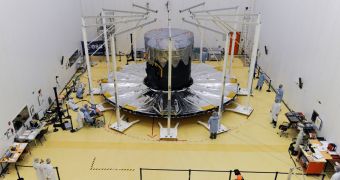Scientists with the Astrophysical Observatory of Turin, in Italy, led by astronomer Alessandro Sozzetti, say that the European Space Agency's (ESA) Gaia spacecraft has the potential to become the first space observatory to use astrometry for detecting extrasolar planets.
Astrometry is a relatively new field of astronomy that centers around establishing the positions of stars in 3D. In the case of Gaia, the telescope will measure how far stars in the Milky Way are from the Sun, with the goal of eventually creating a 3D map of the galaxy over 5 years.
ESA officials say that the spacecraft will investigate the positions of at least 1 billion stars in the Milky Way over the course of its mission, around 1 percent of the total number of stars in the galaxy. Numerous stars from nearby galaxies will be studied as well.
At this point, Gaia is scheduled to launch tomorrow, December 19, from a dedicated Soyuz launch pad built by the Russian Federal Space Agency (RosComos) at the ESA Kourou Spaceport, in French Guiana. The spacecraft will be taken to orbit aboard a Russian-built Soyuz-FG delivery system.
Sozzetti says that Gaia has the potential to discover as many as 2,500 new planets during its mission. This would be a much lower yield than the one provided by the NASA Kepler telescope, which detected around 3,600 exoplanets while in orbit. However, Gaia is not a dedicated planet hunter.
The European telescope will accomplish its mission by surveying the positions of 1 billion stars in 70 full-sky surveys. With each pass, Gaia will determine how the position of the target star has shifted from its previous position, and this ability can be used to detect extrasolar planets.
In a new study, published in the November 11 issue of the journal Monthly Notices of the Royal Astronomical Society, Sozzetti and his team detail a computer model of Jupiter-sized exoplanets orbiting the 3,150 red dwarf stars thus far identified within a 110 light year radius of Earth.
Results showed that Gaia could potentially discover 11 new gas giants around this stellar population. The planets have to be located between 0.5 and 3 astronomical units (average Earth-Sun distances) of their parent stars in order for them to become visible to Gaia. The telescope could focus its capabilities on the roughly 415,000 red dwarfs that orbit within a 325 light-year radius around Earth. Within this stellar sample, Sozetti argues the telescope could find around 2,600 new exoplanetary candidates.
“The combination of Gaia and Kepler data will allow for a much improved understanding of planetary systems' properties and frequencies as a function of the host stars' characteristics,” Sozzetti explains, quoted by Astrobiology Magazine.

 14 DAY TRIAL //
14 DAY TRIAL //